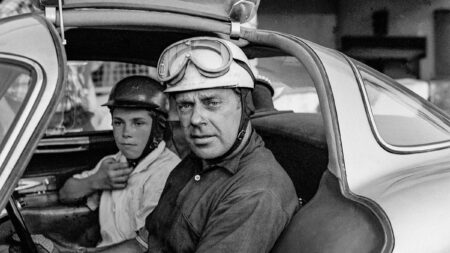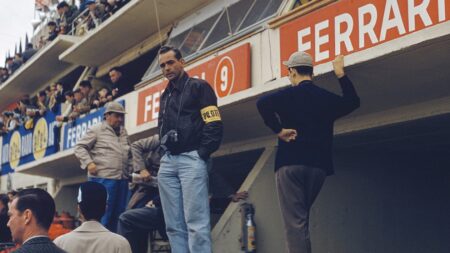“I had a girlfriend with me in a little Citroen, and we set off in convoy. Then there was no autostrada and no ring road around Milan. I drove through the Piazza Duomo to the applause of pedestrians. Of course, the Ferrari had no lights, so I had to follow my girlfriend pretty closely. And I had no mudguards, no licence plates, no insurance, nothing!”
With bright yellow Belgian paintwork and open exhausts, the GP Ferrari was hardly inconspicuous, yet Jacques was not stopped once. Italian Customs officers cheerfully waved him through to Switzerland, but he knew that he might get a different reception going into Belgium so, at the border, he ducked down in the cockpit and drove under the barrier. To his relief, he was not stopped and arrived in Chimay in time for Roger Laurent to start the race. It would be nice to report that all of Jacques’ fine efforts were well rewarded, but Laurent crashed on the opening lap.
While driven by Laurent and de Tornaco, the F2 Ferrari had no real success, but in July, 1953 Swaters himself scored the team’s one and only victory with the car, in the Berlin GP at Avus. “That was very significant for me. It was not too long after the war, and so it felt very good to win in Germany!”
It was about then that Jacques’ business association with Ferrari began, in a rather haphazard fashion via a telephone call from Gerolamo Gardini, Enzo Ferrari’s General Manager.
“For 30 years I had no contract with Maranello — everything was done on a handshake with Enzo Ferrari.”
“He called one day to say, ‘We have sent a car to the Brussels Show and it is on a train somewhere. I have no time to deal with it, can you?’ I went to the station, found the car on a wagon, sorted out the import details and took it to the Show. Gardini called again to say he could not come to Brussels and would I look after the stand? I did, and sold my first Ferrari. As a result, I was asked to become the Ferrari importer for Belgium. For 30 years, I had no contract with Maranello; everything was done on a handshake with Enzo Ferrari. To begin with, I took three or four cars per year, but in 1957 I took 17.”
Swaters’ remarkable relationship with the Prancing Horse has been celebrated in several Ferrari magazines, but British enthusiasts would not wish for his very successful association with Jaguar to be overlooked. It began in 1953, as he recalls.
“Joska Bourgeois, the Belgian importer for Jaguar, was a good friend of ours. She was very close to the factory and introduced me to Lofty England. I ordered a C-type for Ecurie Francorchamps.”
They almost didn’t get it, as all the production cars had been allocated. One of them was being built for Ian Appleyard, who was planning to rally it, but eventually he decided to have a new XK120 instead. So his car XKC 047, which had already been painted Appleyard White, was sold to Ecurie Francorchamps and resprayed Belgian yellow. It was prepared for Le Mans by two of Jaguar’s mechanics who joined the Ecurie for the race.
Practice revealed a considerable performance differential between the works cars and drivers and the privateers. Duncan Hamilton and Peter Whitehead both made a fastest lap of 4mins37 secs, whereas the best Charles de Tornaco could do was 5mins3 secs. Nonetheless, he and Roger Laurent did well to finish ninth overall, almost 250 miles behind the winning works C-type of Tony Rolt and Hamilton.

Swaters drifts his Ferrari 750 Monza through one of the Dundrod’s circuits dangerous corners in 1955
Getty Images
Sadly, three months later, de Tornaco was killed when he overturned the F2 Ferrari in practice for the Modena GP. There was no doctor present, let alone an ambulance, and de Tornaco went by car to the hospital, where he died of a fractured skull.
Formula One returned for 1954 and the F2 Ferrari gained a 2.5-litre engine and was campaigned by Swaters and Laurent. They had no real Success, their best result being the latter’s third in the Finnish GP.
They fared better with Jaguar, despite the fact that their car was crashed by a works mechanic shortly after leaving Calais on the way to Le Mans.
“It was too badly damaged to race,” recalls Swaters. “I went to see the President of the AC de l’Ouest with tears in my eyes and he said we must be at Scrutineering the next morning. Lofty England then offered to bring over a complete body/chassis from the factory, into which we could put our engine and transmission. I went back to the President and cried some more. He told me that if I presented the crashed car at scrutineering it would be refused, but that I could present it again on the Friday night.
“Lofty was fantastic. He called Coventry and told them to send over the spare chassis (XKC 012) by Silver City Airways. We collected it at Le Touquet on the Wednesday afternoon, took it to Le Mans and worked through to Friday night.
“There was no time to change the colour from BRG to yellow, so we painted a yellow stripe down the middle. At 11.30pm I took it to scrutineering and at 11.55 did the two laps necessary for starting the race. Roger Laurent and I then finished fourth, which was a wonderful result, in the circumstances.”
They did even better at Reims in July, finishing third behind two works D-types in the 12-hour race. “During the last hour, I was in a big battle with Masten Gregory in a 4.1-litre Ferrari. It was touch and go for the final ten laps, because the C-type was all over the road and I didn’t know why. Nor did I dare stop to find out, as Gregory was so close, but afterwards my mechanic pointed out that most of the spokes on a front wheel were broken.”
Swaters beat Gregory to third place by a couple of hundred yards. The next month, Roger Laurent was third again, in the Dutch Sportscar GP at Zandvoort, but in the Tourist Trophy in September, he and Swaters could only finish 16th.

Olivier Gendebien and Paul Frére: two of ENB’s most favoured drivers
Getty Images
For 1955, Jacques joined forces with Johnnie Claes and gained sponsorship from Belgian Shell. However, Shell wanted a team with a name that was more representative of Belgium than Ecurie Francorchamps, so Jacques founded Equipe National Beige. They bought a couple of Ferrari 750 Monzas (0518 & 0552), racing at Dakar, Spa, Bari (where Laurent wrote off 0552) Chimay and Durkirod. Their best result was second (Swaters) and third (Laurent) at Spa, but as they were beaten by Frere in a bog-slow Aston Martin DB3S their best was not good enough.
The team also acquired a D-type Jaguar (XKD 503), in which Swaters and Claes finished third in the tragic Le Mans. The car was sold to an American.
For the 1956 Le Mans, ENB bought XKD 573 and Swaters and Freddy Rousselle finished fourth. Andre Pilette was second at Montlhery. The Jaguar was then works-prepared for the 1957 Le Mans, where it again finished fourth, Rousselle driving this time with Paul Frere. It was fourth at Spa (Rousselle), fifth at Saint Etienne (Lucien Bianchi) and sixth in the Swedish GP (Claude Dubois). Swaters then sold the D-type to Baron Janssen de Limpens of Brussels, who used it as a road car. Since 1963, it has belonged to John Coombs.
Swaters describes the D-type as the best car he drove at Le Mans, but in the ’57 race he shared a 290MM Ferrari with Alain de Changy. Which was a shame: they failed to finish what was Jacques’ last race. “Garage Francorchamps was growing and it made sense to devote more time to that.”
On the Ferrari front, the previous year Equipe National Beige had acquired two TR 500s (0600 & 0618), which were not a great success, while in the meantime, Olivier Gendebien had found his way into the team. He really caused a stir at the end of 1956, finishing third with a 250GT in both the Liege-Rome-Liege rally and the Tour de France.
“Stirling Moss was the best driver of his time, but he was never World Champion. In the same way Mairesse was by far the best Belgian driver, but he never won big races.”
In April, 1957, with his cousin Jacques Washer as passenger in the 250GT 0677, Olivier scored a brilliant victory in the Tour of Sicily and then was a stunning third overall in the last Mille Miglia. Driving the same car, he and Paul Frew won the Reims 12 Hours and then wrapped up the season with a win in the Tour de France, with Lucien Bianchi. In the meantime, Bianchi and Harris had won the 2-litre class at Le Mans in ENB’s 500TRC.






